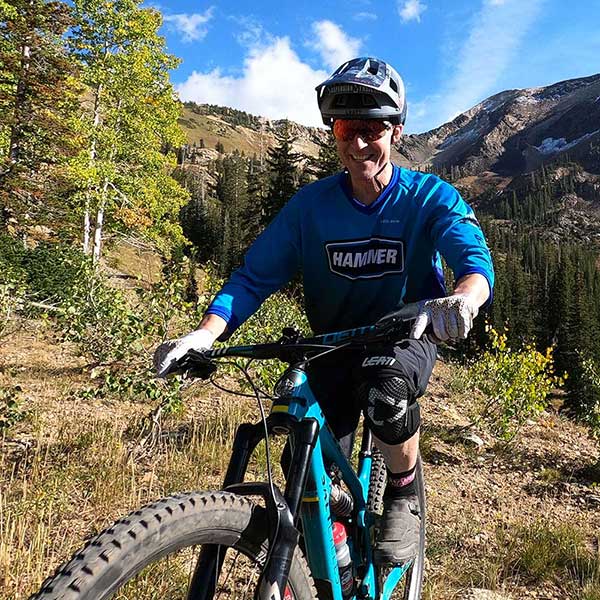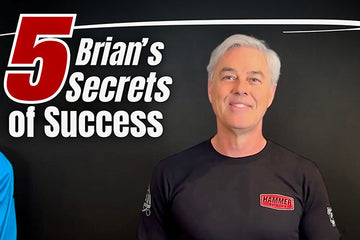aka Keto and IF
BY BRIAN FRANK
The latest diet craze that’s been wildly popular and has been used to sell billions of dollars worth of products has been around for several years now and goes by the label of "Keto" or "ketogenic diet". Likewise, Intermittent Fasting (IF for short) has also gotten a lot of coverage as of late and is often tied to the Keto diet. Despite my disdain for labels, especially when used for marketing hype, they are both extremely effective—separately or combined—ways to eat when one wants to get off the sugar/carb merry-go-round and change from a carb burner to a fat burner while exercising and in life. I support any idea that includes or leads to the avoidance of sugar and sugar-like foods. But exactly how do you go about adopting these habits while training 8, 12, 15 or more hours per week? Addressing that is my intent here and in future articles.
When we drop the labels, dogma, and slavish adherence to these protocols, they become a sustainable and enjoyable way of eating and living, with extensive health and performance benefits, especially for endurance athletes!
The most important takeaway is that strict adherence to these concepts is neither enjoyable nor necessary for most people, nor does it lead to peak performance on race day. For this reason, I am trying to move away from these labels to a more flexible and sustainable way to approach the gargantuan subject of food – both type and timing. Dr. French refers to a "hybrid" approach to Keto. Whatever you call it, by changing your macronutrient ratios (more protein and fat, less sugar/carbs) and compressing the number of hours in the day that you eat by as much as makes sense for you and your schedule/routine, you too can lean out, reduce cravings and energy swings, while improving fat metabolism for energy needs. Win-win-win!
We've been discussing these topics over the past couple of years in EN and most recently on a regular and more in-depth basis, in this pub and our online version, Endurance News Weekly. If these two topics and their related topics are of interest to you, and I certainly hope they are, be sure to tune in every Thursday when that email lands in your inbox with fresh new articles on these and related topics.
These articles have been generating a lot of comments from readers and have pointed out the elephant in the room, so to speak: How does an athlete who wants to train 10-15 + hours per week incorporate this eating style and timing into their daily routine? Given the wide variations in athletes' training routines, work schedules, family life, and fitness goals, I'm going to discuss general considerations and then show some hypothetical scenarios to get from the general to specifics of this journey.
Dietary habits – macronutrient composition
The high carb, so-called "heart friendly" diets of the 70's and 80's gave way to higher fat and protein diets in the 90's with the "40-30-30" diet that started the trend, followed by Atkins, Paleo, a few others, and most recently the Keto diet. These later three represent the first time where carbs—an over-generalized term that is confusing and does not serve us well; see my previous article on “good carbs and bad carbs”)—were limited or removed from the daily diet. The thing all these diets have in common is the plethora of pricey packaged and processed foods that adherents need to buy to "follow" the diet. In this regard, the "keto" diet may be the biggest offender here – keto cereal, keto snack bars, keto beverages, chips and breads, and of course, the uber-pricey "ketone" products added on top of all of the others.
The second common feature is that they are hard to follow; most people usually slide back into their old eating habits. The challenges and expenses of following these diets and the financial costs of all the associated products become unsustainable. Possibly a more significant factor is the constant temptations we all face with the nonstop marketing of grain and sugar products everywhere we go. The Standard American Diet (SAD for short), followed a lot or a little, leads to ruin, but this extremely addictive merry-go-round is so, so hard to get off!
It does not help that sugar is as physically addictive, and a single exposure can create a lifelong struggle and a vicious “sweet tooth”. Additionally, commonly consumed artificial sweeteners have been shown to inhibit satiety. Throw in a healthy daily dose of high-gluten sugar-like grain products in the form of bread, crackers, and pasta, and you'd be looking at the Standard American Diet.
It's been suggested switching to a whole foods-based, high fat/protein, low-carb diet and or restricting eating times will cause or contribute to eating disorders. I believe the opposite to be true and have quite a bit of supporting data that eating the SAD leads to many of the "eating disorders" that 5-40% of athletes, and similar stats for the general population, are said to experience. Cut the sugar and sugar-like foods, and the cravings will go away. Another topic worthy of much further exploration.
Further complicating eating habits, and this discussion, is the “hunger” hormone ghrelin, which is triggered by—you guessed it—sugar and starchy sugar-like carbs. Its vicious circle of constant daily consumption of these foods leads to long-term elevated ghrelin levels and the raging appetite that goes with it. Conversely, limiting the type of carbs we consume and the times of day they are consumed can tame this hormone and the outsize appetite that goes with it. It will take 4-6 weeks, but as ghrelin levels normalize, it reduces sugar/starch, and cravings for foods (bread, pasta, crackers, cookies, etc.) subsides.
Changing your diet and macro’s
Whether you are intentionally following any of a dozen or more “low fat” diets as advocated by so many different experts, I’ve lost count, or just kind of free range, a lot of us end up eating 65% to 80% of our daily calories in the form of carbohydrates, of one kind or another. Certainly, the authors talk about avoiding refined carbohydrates but also encourage a diet that mainly consists of grains, fruits, and vegetables, most of which will be recognized as sugar in the body and the way it processes them metabolically. Besides the excess carbs, as the name suggests, these diets all require the avoidance of most fats and treat protein as an afterthought. It's hard to fault the creators of the low-fat diet since they were relying on corrupt science which blamed dietary fat/cholesterol for heart disease, still our #1 cause of death today.
It is for these reasons that I've embraced any diet, like those mentioned earlier, to come down the pike that encourages more protein and fat intake and less sugar/carbs. On the other hand, I also shun any diet that doesn’t allow one freely eating zucchini, celery, etc. Avoidance of healthy vegetables is my main criticism of any attempt at strict Keto diet adherence. The point is not to eradicate ALL carbs from your diet! There is no need to do this, especially if you are an endurance athlete.
What is needed is to replace the packaged, processed, refined sugars and starches with whole food sources of good carbs and lots of protein and fat from animal, plant, or a combination of the two. If you do this for all your meals and snacks, you’ll be on the right track.
Instead of cheese and crackers, replace the crackers with celery and cucumber wedges for dipping. Instead of bread sandwich, have all the fixings wrapped in lettuce or tossed on top of a bed of greens. Not Keto or Paleo, but it works.
Before moving on to the discussion of Intermittent Fasting, aka time-restricted eating, compressed eating window, I do want to stress the fact that changing your diet as discussed above is needed/required in order to engage in any type of intermittent fasting successfully. Good thing the two go hand in hand – less appetite and cravings allow for longer periods of satiety without consuming calories.
IF
The most basic definition of Intermittent Fasting is an eating pattern where you have periods of eating and longer periods of fasting. The most popular method is 16/8 – where you limit your eating window to 8 of your waking hours during the day and then do not eat for the other 16. We all fast overnight while we sleep, so the way to achieve this is by extending the fast after waking or starting the fast several hours before going to bed.
Since many people eat for most of the 14-16 waking hours in a day, reducing this to 8 hours takes determination and willpower for a few weeks. Incorporating IF into an endurance training routine without compromising training or recovery is where most get lost. To illustrate how this can be done, I will give some examples below.
Things to consider before going down this road
Low Cho diet and IF is not about calorie restriction at all. Calorie restriction should only be practiced if weight loss is desired. It's about eating the same number of calories from different sources during an 8-hour window instead of 12 + hours.
Goals and priorities will change your approach and whether or not it will be manageable for you. Be it peak performance, improving your body mass index or general health and well-being, or addressing myriad metabolic syndromes, these two tools can be extremely effective. The different "case studies below are intended to help clarify the hows.
Consuming calories during exercise – This is where the baby gets thrown out with the bath water when people try to go hard-core Keto. Exercising in a fasted state for more than 30-45 minutes at a high-intensity rate doesn't work well; however, if the pace is at/below 50-60% of AT/Vo2max, you can go for a couple of hours. That said, extended exercise beyond 3 hours at any pace on zero carbs also doesn’t work well.
Additionally, and possibly more importantly, is whether you count the time spent training and consuming some calories as part of your fasting or eating window. The strict IF approach would be to include that time in your eating window, making it very hard for high-volume/intensity athletes to easily follow IF. If you are starting a workout in a fasted state and consuming < 200 calories per hour while simultaneously 2/3 of spent calories are coming from burning fat, you're not fasting, but you're also not eating and digesting a meal. I know, big curveball to throw in here, but also food for thought and future articles.
Post-workout recovery: immediately or wait 1-2 hours? – I've advocated the importance of complex carbs, protein, and electrolytes immediately after workout out for over three decades in the strict context of optimum recovery. That is still my sincere belief if peak performance and fitness is your top priority. If this is not your case, intentionally delaying the introduction of calories after working out will slow muscular repair/recovery and glycogen replenishment a bit. However, it will also cause you to keep burning fat at a high rate during this gap.
Lastly, perhaps one of the biggest factors when considering IF is social and familial priorities. For example, if eating dinner with your family at 6:30 or 7:00 PM is your priority, an IF window between 8:00 AM and 4:00 PM doesn’t work, but 11:00 AM – 7:00 PM might unless you also want to train hard early in the morning. Conversely, if you are an early riser and do all of your training before 8, that 11-7 window likely will not work for you. For others, the 16/8-hour window just won’t work every day, and that’s ok too.
Case study #1 – 45 years old, works full time, family, training 12-15 hours per week, wants to improve BMI and lose 10 pounds, eating window varies from day to day:
- Sunday: Rest day; eat desired # of calories between 11:00 AM and 7:00 PM
- Monday – Friday: 7:00 AM wake, coffee, 60 minutes of light cardio, gym work, etc., with no calories, keep the burn going until 11:00 AM, large meal. Midday meal at 2:00 PM, 5:00 PM, 60-90 minutes high-intensity training, dinner at 6:30 PM – 7:00 PM, bedtime 10:00 PM.
- Saturday: Early morning, long day. 7:00 AM wake, coffee, go exercise for 2-4 hours, consuming 150-180 calories per hour of complex carbs, Recoverite immediately after, followed by big lunch. If you want to stay strict IF and burn more fat, have another meal around 3:00 PM and shut it down for the rest of the day. More realistically, still, count your window opening at 11:00 AM, have a light afternoon snack, and then have family dinner.
Case study # 2 – 60 years old, flexible schedule/remote work, single, early riser, early to bed, trains 15-20 hours per week, good BMI.
- Monday to Sunday – 8:00 AM – 9:00 AM to 4:00 PM – 5:00 PM eating window. Plan your workouts and meals, so they fit best with your social/work/hobby schedule and enjoy.
Case study # 3 – 30 years old, physical job, trains 8-10 hours per week, lives alone, active social life – 16/8 maybe not practical, try 14/10.
- Monday-Friday 8:00 AM – 6:00 PM window.
- Monday, Wednesday, Friday: gym 6:00 AM to 7:30 AM, breakfast to follow, big lunch, early dinner.
- Tuesday, Thursday: 12:00 PM – 8:00 PM window, no AM workout, 30-60 minutes of cardio after work, dinner done by 8:00 PM.
- Saturday: Early window. Early rise, big exercise, early meals, early to bed.
- Sunday: Later window. Sleep in, relax, have coffee, eat around 11:00 AM, enjoy your day, have dinner between 6:00 PM – 7:00 PM, and get ready for another week ahead.
These are by no means meant to be the only way to approach these ideas, nor is this article intended to be conclusive or definitive. On the contrary, it's the start of a very long conversation.











10 comments
Hi Brian, thank you for your article on compressed eating. I’ve been doing the LC/IF (16/8) for a few months now mostly to tame a elevated A1C. Looks like it worked as my A1C went down from
6 to 5.6. I usually fast from 8 pm to 12 pm the next day. I usually run in the morning. My main issue right now is a constant low energy. When I wake up my energy level is really low. I run on it nonetheless but my pace is really slow (I’m 60 years old). I’m also hesitant to break the fast and low carb diet right after my runs if they are in the first half of the morning. Is there anything I can do different to overcome the low energy. Or will that low energy feeling settle after a while on the diet (I’ve been doing it for about 3 months now). Thank you.
———
Hammer Nutrition replied:
Hello Fabrice, Thank you for your comment, it’s my pleasure. I’m encouraged by the results, but not the low energy levels. You should not have to “settle” with permanent lethargy to avoid type II diabetes. I’d be happy to continue this conversation with you directly, so please let me know if you wish. My first question is why the 12-8 pm window? Especially if you wish to workout in the morning. If it doesn’t interrupt your social/family life too much, moving the window earlier to say 10 am to 6 pm, may help a bit. However, I think the bigger issue may be the low amount of good carbs in your diet and exercising without any. Sparing use of complex carbs at the onset and during runs at a faster pace than a shuffle (about 100-150 calories per hour) should make a huge difference. IMO the beneficial results you’ve experienced so far have been from the compressed eating and lowering sugar intake. Adding things like salads and non starchy vegetables to your meals will help with maintaining muscle/liver glycogen levels in addition to the suggested dietary changes. BDF
great article – thank you for the scenarios – I like that you focus on some flexibility and balance -
I’m looking forward to more – future articles on this topic.
My story is too long to tell here, but it started with Keto over a year ago, then morphed into TKD, and now, I’m basically broken and trying to recover. It’s possible I’m experiencing RED-S, or some form of it.
I really believe in the health benefits of IF and LC, but these are almost impossible to manage when burning an extra 8-10K calories per week. I’m currently trying to use everything I’ve learned about how and what to eat, and adjust so that my performance gets back to normal, while still maintaining a healthy diet.
Low T is my biggest issue right now. Admittedly, Keto over the winter when my calorie burn was half, worked out well. Along with IF, I never felt better overall, at 63 years old.
Great article!
Thanks, Frank
———
Hammer Nutrition replied:
Hi Frank, Thank you for your comment and sharing your experiences. So sorry about the rocky road you’ve been on recently. I had to look up RED-S (Relative Energy Deficiency in Sport). This space is limited, but I’ve got ideas for your low T (Boron and others) and finding a more flexible eating style that will meet your needs while enjoying the benefits of low carb/time compressed eating if you’d like to continue this discussion via email or phone. BDF
Great article, touching multiple problems. Keep’em coming!
As an example my problem is scheduling… I frequently exercise between 5-6 am.
My priority is BMI balance, so I decided to compromise on “optimizing performance”, and I don’t eat after workouts.
I do gulp Enduralytes to avoid headaches during longer IF’ing.
So far so good.
———
Hammer Nutrition replied:
Hello Sebastian, Thank you for your comment! You are not alone in your early am training routine – A lot of our clients do the majority of their training in the very early am, but also train and or need to eat socially after 5. Don’t have a name for it yet, but I’m experimenting a slip split eating window for this type of schedule – Example, open window at 5 am on hard training days, consume carb calories during training, have recovery mix post, then eat a large meal and begin fasting again by 9 or so, until 5 or so, 2nd workout and or dinner by 7ish – fast from then until bed. It seems to me that this schedule, combined with the requisite high protein/fat, low carb macro nutrient intake, could work quite well. I’ll be writing more about these types of variations in the coming weeks. BDF
Reading the lipid article and get to end and to continue reading i am led to a QR link.
Guess what, there is no continuation of the article, just a low carb article. What gives?
———
Hammer Nutrition replied:
Hi Bill, thank you for reading the article! The QR code leads to our Endurance News Weekly landing page. Once there, you’ll have to scroll down on your phone to find the “Low Carb Diet and Compressed Eating” article – If you have any questions, feel free to reach out and let us know! – Lacey